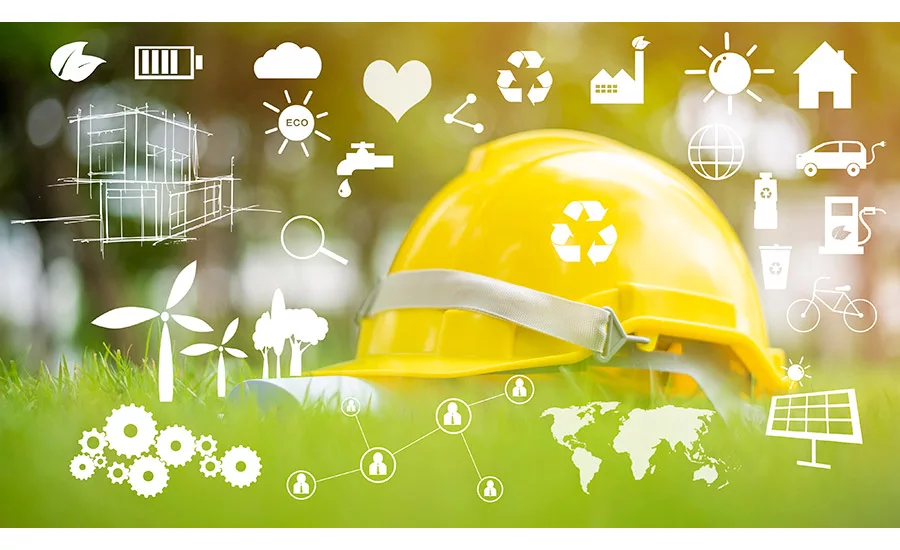Market Trends
Growth Projected for Green Building Materials
Despite pandemic-related setbacks in the construction industry, multiple factors are creating expanding opportunities for green building materials.

Green building materials are defined as those that are non-toxic, improve occupancy health, lower cost, and conserve energy. A green building’s operating costs are typically lower than a traditional building, with 63% less water usage and 53% less electricity usage. The green building materials market was estimated at $199.9 billion in 2020, according to a report by Mordor Intelligence, and is projected to register a CAGR of over 9% from 2021-2026.
According to a 2019 report by the U.S. Green Building Council, the number of Leadership in Energy and Environmental Design (LEED)-certified homes has grown 19% since 2017. The current level represents an all-time high, with nearly 500,000 single-family, multi-family, and affordable housing LEED-certified units globally. More than 400,000 of these units are located in the U.S.
COVID-19 Impact
As several countries were forced to go into lockdown due to the COVID-19 pandemic, construction work stopped all across the world. Major construction hubs like China, India, and Japan were particularly affected. Supply chain disruptions, work stoppages due to measures imposed by government authorities to slow the spread of the virus, and workforce shortages due to illness and preventative quarantines all negatively affected the market. While these issues served as a stumbling block for the demand and use of green building materials, the market is expected to recover in the coming years.
In the short term, increasing demand for energy-efficient buildings and insulation, as well as favorable government policies for green buildings, are driving the market’s growth. On the flip side, high capital investment when compared to conventional buildings and the impact of COVID-19 on the market are likely to hinder growth. The declining cost of green buildings over time and increasing awareness about recycled construction are likely to provide opportunities during the forecast period.
Residential Segment to See Strong Growth
Green building construction in the residential sector is increasing due to the rising number of building regulations and policies mandating energy-efficient structures. This has created a market for environmentally friendly and energy-conserving materials used in residential construction. With growing public awareness and rising income levels, the use of green building materials and the growing trend of energy-efficient structures in high-rise residential buildings and townships are likely to further boost demand for green building materials.
Various types of green building materials are gaining popularity in residential buildings, including those that are energy efficient, moisture resistant, durable, and easy to maintain. Green building materials are becoming hugely popular in Canada, Germany, the U.S., and other Western European and Scandinavian countries.
In the Asia-Pacific region, countries such as China and India have been facing environmental pollution-related problems, earning the attention of governments to take the initiative. Moreover, power shortage problems in developing nations like India, South Korea, Sri Lanka, and others are likely to promote the concept of green building construction to promote daylight harvesting.
On the other hand, the green building construction sector in North America and Europe is already widely popular. Thus, growing renovation projects in North America and the recovering construction industry in Europe are likely to further increase the consumption of green building materials over the forecast period.
North America to Dominate the Market
The construction sector in North America has been witnessing growth due to increased demand for houses and a rise in renovation projects. Various government efforts and regulation mandates, such as LEED, Green Building Certification, subsidies for green housing projects, and others, have been driving the construction of green buildings in the region.
The U.S. witnessed noticeable investment in residential construction in 2019. In addition, LEED registrations in the U.S. continue to increase, reaching 69,006 registrations in 2019.
Similarly, in Canada, Toronto and Vancouver have become hotspots for construction, propelled by a hot real estate market. Developers have been looking forward to good returns on investment in the country, particularly with high-density residential projects. According to the Canada Green Building Council (CaGBC), the Canadian green building sector can contribute $150 billion to the GDP by 2030 while cutting greenhouse gas emissions (GHGs) by 53 megatons compared to 2018 levels.
Mexico has also been witnessing high housing demand, and the country is attracting noticeable construction investment. For instance, in January 2019, IDB Invest, a private sector institution of the Inter-American Development Bank (IDB) Group, granted a local currency financing program to the Mexican company Procsa in order to finance land acquisition, development, and commercialization of housing for low and middle-income families in the country.
Additional details are available at www.mordorintelligence.com.
Note: Opening image courtesy of tonefotografia via iStock/Getty Images Plus.
Looking for a reprint of this article?
From high-res PDFs to custom plaques, order your copy today!




.webp?height=200&t=1634732409&width=200)


